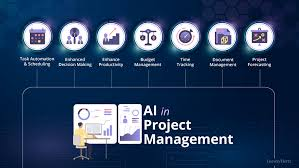The Agile Revolution in Project Management
In the modern business landscape, speed, adaptability, and customer-centricity define success. Traditional project management methods—rigid and linear—often fail to meet the evolving demands of dynamic industries. Enter Agile Project Management, a methodology that emphasizes iterative development, collaboration, and continuous improvement.
Originally rooted in software development, Agile has now
transformed industries ranging from finance and healthcare to marketing and
product development. In 2025, mastering Agile isn’t just a skill—it’s a strategic
advantage.
"According to the State of Agile Report (2024),
over 81% of organizations have adopted Agile to some degree, and
those with mature Agile practices are twice as likely to meet their
business goals."
What is Agile Project Management?
Agile is not a single framework, but a mindset guided by
core principles:
- Customer collaboration over contract negotiation
- Responding to change over following a plan
- Working solutions over comprehensive documentation
- Individuals and interactions over processes and tools
Agile methodologies include:
- ·
Scrum: A time-boxed, sprint-based approach ideal for
cross-functional teams.
- ·
Kanban: A visual system that focuses on continuous
delivery without overburdening the team.
- ·
SAFe (Scaled Agile Framework): Designed for large
enterprises with multiple Agile teams.
- ·
Lean: Focuses on value creation and waste elimination.
Why Agile Matters in 2025
1. Rapid Response to Change
In today’s volatile market, plans can become obsolete
overnight. Agile equips teams with the ability to pivot quickly without
losing focus, allowing businesses to respond to market trends, customer
feedback, and disruptive technologies in real time.
2. Enhanced Stakeholder Engagement
Agile encourages frequent interaction with stakeholders,
ensuring that deliverables align with expectations. Regular reviews and demos
create transparency, reducing misunderstandings and last-minute surprises.
3. Improved Product Quality
Agile promotes iterative testing and feedback loops,
which means bugs and design flaws are detected early. Teams can deliver better
quality products that meet or exceed customer expectations.
4. Higher Team Morale and Collaboration
Agile empowers self-organized teams and promotes a culture
of trust, ownership, and accountability. This results in improved team
morale, innovation, and performance.
5. Faster Time-to-Market
By breaking projects into smaller, manageable iterations,
Agile teams can deliver value faster and more frequently. This approach
significantly reduces time-to-market, giving companies a competitive edge.
Real-World Application: How Spotify Scaled with Agile
Spotify is one of the best-known companies leveraging Agile
at scale. They developed a model of Squads, Tribes, Chapters, and Guilds,
allowing teams to stay autonomous while aligned with overall goals. This
decentralized structure has allowed Spotify to continuously innovate, release
updates faster, and maintain an agile mindset at all levels of the
organization.
Common Challenges & How to Overcome Them
1. Resistance to Change
Not all teams embrace Agile right away. Solution: Provide
training, mentorship, and highlight small wins to build confidence.
2. Lack of Skilled Agile Leaders
A successful Agile transformation requires certified
Scrum Masters, Product Owners, and Agile Coaches to lead the change. Invest
in professional development.
3. Misapplication of Agile
Trying to "do Agile" without understanding its
principles can cause failure. Solution: Begin with pilot projects,
then scale responsibly.
Tools That Make Agile Work
- ·
Jira – The gold standard for Agile tracking and
Scrum sprints
- ·
ClickUp – Combines task management, docs, and
Agile boards
- ·
Monday.com – Visual Agile planning with custom
workflows
- ·
Miro – Whiteboarding tool for retrospectives and sprint
planning
- ·
Asana / Trello – Lightweight boards for teams
transitioning to Agile
The Future of Agile: AI-Driven Agile Management
As AI continues to integrate into every business
function, Agile project management will become even smarter. Predictive
analytics, intelligent backlog prioritization, and AI-driven sprint planning
will soon be standard practice.
AI is expected to:
- ·
Forecast team velocity with greater accuracy
- ·
Recommend user stories based on customer data
- ·
Optimize resource allocation in real-time
“By 2026, Gartner predicts that 70%
of Agile teams will use AI-augmented project management tools to improve
performance and reduce administrative tasks.”
Agile is No Longer Optional
In the relentless pace of today’s business environment, Agile
is the mindset that separates leaders from laggards. It’s not just about faster
delivery—it's about delivering the right value at the right time, continuously.
Companies that embrace Agile in 2025 will be more resilient, innovative, and
successful in the face of change.
🚀 Ready to go Agile?
Whether you're a startup or an enterprise, adopting Agile could be your game-changer. At Project Edge Hub, we bring you expert insights, tool reviews, and real-world strategies to future-proof your projects so stay Connected to our Blog.








